Introduction
Front
{{section_header}}{{section.name}}{{/section_header}}
The front of the Toshiba 32C100U is ringed with glossy black plastic, which isn't the most attractive setup we've seen. The tiny red light in the bottom left corner is a power indicator.

Back
{{section_header}}{{section.name}}{{/section_header}}
The back of the TV features a cluster of ports off to the right side.

Sides
{{section_header}}{{section.name}}{{/section_header}}
The left side of the TV has the on-set controls and a USB port. The right side is featureless.

Stand/Mount
{{section_header}}{{section.name}}{{/section_header}}
The TV's mount is fairly cheap, but it seems to do the trick. It's a glossy black plastic, an aesthetic which tends to look ugly.

Controls
{{section_header}}{{section.name}}{{/section_header}}
The TV's remote looks a bit '80's, and features only basic functionality.
Remote Control
{{section_header}}{{section.name}}{{/section_header}}
The TV's controls are located on its left edge and cover all the basic functionality.

In the Box
{{section_header}}{{section.name}}{{/section_header}}
In the box you'll find the remote, batteries, and manuals. There aren't any extras included.
The TV isn't very hard to set up. You just have to put the stand in the right place and secure it with a few screws.
Black Level
{{section_header}}{{section.name}}{{/section_header}}
Our threshold for a nice, deep black level is 0.10 candelas per square meter (cd/m2). Anything brighter than 0.20 cd/m2 is mediocre, anything brighter than 0.30 cd/m2 will have noticeably bright-looking blacks, and anything below 0.10 cd/m2 is amazing. The Toshiba 32C100U finds itself squarely in the "amazing" category with its black level of 0.07 cd/m2. This is a great black level for an LCD, whose backlights make a low back level difficult to achieve. More on how we test black level.
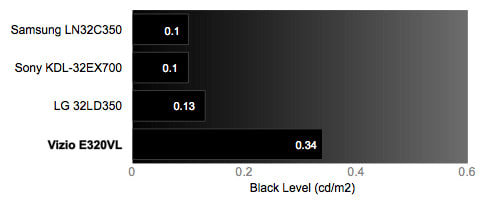
Peak Brightness
{{section_header}}{{section.name}}{{/section_header}}
The TV faltered on our peak brightness test, only offering 139.86 cd/m2—quite a bit dimmer than our benchmark for adequate brightness, 200 cd/m2. This means everything on the TV will look a bit duller than it should (for example, whites will always look a bit grey compared to a brighter TV) and, as you'll see on our reflectance test, external light washes out the onscreen image. More on how we test peak brightness.
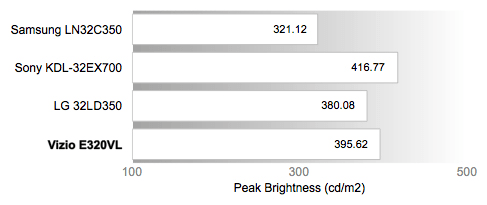
Contrast
{{section_header}}{{section.name}}{{/section_header}}
With a great, deep black level and a disappointing peak brightness, the 32C100U has an above average contrast ratio. Don't expect the highest level of differentiation between shades, but most viewers won't be disappointed by the level of detail. More on how we test contrast.

Tunnel Contrast
{{section_header}}{{section.name}}{{/section_header}}
One issue the 32C100U has is tunnel contrast. When there's only a small amount of black onscreen, gets washed out by the surrounding brightness. The black level can more than triple in brightness. More on how we test tunnel contrast.
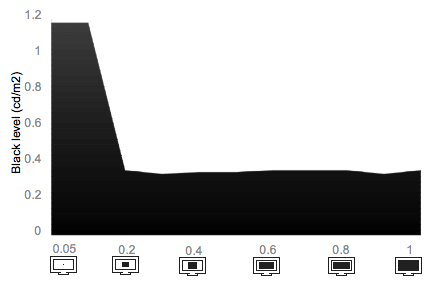
White Falloff
{{section_header}}{{section.name}}{{/section_header}}
The TV didn't have much of a problem with white falloff, which is good because the TV doesn't have much white to begin with. Expect your 32C100U's white level to remain more or less consistent. More on how we test white falloff.
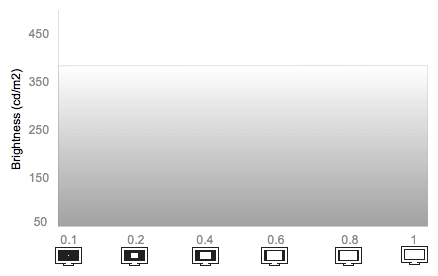
Uniformity
Greyscale Gamma
{{section_header}}{{section.name}}{{/section_header}}
Greyscale gamma refers to the curve along which a TV's greys darken to black and brighten to white.The ideal slope for this curve is somewhere between 2.1 and 2.2. The Toshiba 32C100U's greyscale gamma is a very aggressive 2.54. That means greys brighten too quickly, losing the small details between shades. Also, there's almost no differentiation in the low end, as seen by the relatively flat line. That means that, although the 32C100U is capable of an impressive black level, it doesn't actually give the TV better dark detailing. Darkness will look a bit flat and homogeneous. More on how we test greyscale gamma.
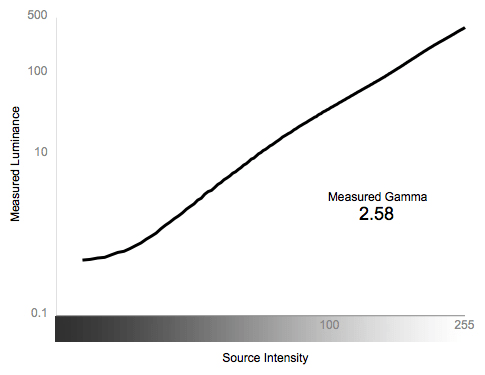
Color Temperature
{{section_header}}{{section.name}}{{/section_header}}
The Toshiba 32C100U's color temperature is pretty even throughout most of the spectrum: its minor shifts aren't perceptible to the human eye. Towards the black end of the spectrum, however, the color temperature shifts warm and keeps getting warmer as the shade gets darker. More on how we test color temperature.

RGB Curves
{{section_header}}{{section.name}}{{/section_header}}
The 32C100U had some pretty uniform RGB curves, but they weren't perfect. The slope of the blue curve was slightly more concave than the red and green lines, but the average user won't likely notice any effects from this. What the average user might notice, however, is the loss of minor detail throughout the RGB spectrum. If you look at the graph below, you'll notice that the lines themselves aren't very smooth: they're filled with tiny bumps. That means adjacent colors are either either slightly too different or not different enough. In areas that call for the smooth transition of color, you'll see the borders of different colors. More on how we test RGB curves.

We've transposed the above data into gradient bars below. Here you can see what the ideal response should be, the 32C100U's performance, and the performance of a few competitors. Vertical bars, which you can see fairly clearly in the gradient bars for the Toshiba 32C100U and the Vizio E320VL, indicate losses of detail.
Motion Performance
{{section_header}}{{section.name}}{{/section_header}}
Motion Smoothness (7.00)
The Toshiba 32C100U was pretty good about showing a smooth motion. It exhibited the same stuttering and loss of fine detail that we see on nearly every LCD television. From a normal sitting distance, if you're watching TV you probably won't notice a problem. For sports viewing, you may see some loss of detail in the faces and uniforms of running players, but no major problems.
Motion Artifacting (5.00)
The Toshiba 32C100U displayed a fair number of motion artifacts. While we've seen similar problems in similar types of televisions, there seemed to be no way to correct them. In fact, when we activated the ClearFrame feature, the artifacts only got worse. Normally, motion smoothing features remove some problems, but add others. In this instance, it simply added to the problems. More on how we test motion performance.
3:2 Pulldown & 24fps
{{section_header}}{{section.name}}{{/section_header}}
The Toshiba 32C100U didn't have any problems displaying 24fps content (the framerate of most Blu-Ray movies). We did notice some minor stuttering in camera pans, though, as well as some minor artifacting in high frequency patterns. Overall, though, we didn't see any real problems with the 32C100U's performance. More on how we test 3:2 pulldown and 24fps.
Resolution Scaling
{{section_header}}{{section.name}}{{/section_header}}
The 32C100U is a 720p display, which isn't the highest HD format. This means it has to do some extra processing to display broadcast HD (1080i) and full HD (1080p) content. Since this processing is never perfect, we test the TV's ability to display nonnative content. More on how we test resolution scaling.
480p
The E320VL did a decent job with 480p signals (standard definition). We saw a small amount of overscan, but otherwise the TV had no issues with 480p content.
1080i
The TV should handle broadcast HD content fairly well. We saw some details lost due to the interlacing and some minor flickering as fine patterns entered the screen, but it wasn't a particularly obnoxious effect.
1080p
The 1080p signals did not look very good. There was a very noticeable amount of detail getting lost, and we saw a lot of artifacting on fine patterns.
Formats
{{section_header}}{{section.name}}{{/section_header}}
The Toshiba 32C100U is a 720p HDTV, which means it can't natively display the highest HD formats available (1080i and 1080p). In order to do so, it has to do some processing, which we found had some negative results.
Viewing Angle
{{section_header}}{{section.name}}{{/section_header}}
The Toshiba 32C100U let's you get up to 31° away from center before you'll only see about half the TV's contrast ratio. This isn't a great viewing angle compared to the near-180° angle you'd get from a plasma, but it's fine for an LCD.

Reflectance
{{section_header}}{{section.name}}{{/section_header}}
External light shining on the TV will create a large, diffuse glow. Since the TV isn't particularly bright, this glow will definitely wash out the screen. This is not a TV you can put near a window that catches a lot of light.
Video Processing
{{section_header}}{{section.name}}{{/section_header}}
The Toshiba 32C100U has several video processing features, but we wouldn't recommend using most of them.
Calibration
{{section_header}}{{section.name}}{{/section_header}}
We actually didn't have to do much to get the Toshiba 32C100U to it's optimal picture quality, as its Preference setting's presets were all about as close to ideal as the TV could get.
One interesting thing to note: it doesn't look like the Sharpness setting does anything. At all.

All of our calibration is done in conjunction with the DisplayMate software.
](http://www.displaymate.com/)
Video Modes
{{section_header}}{{section.name}}{{/section_header}}
There are only a handful of preset modes, but you can't make any changes to them: you'll automatically get bumped into Preference mode.
Ergonomics & Durability
{{section_header}}{{section.name}}{{/section_header}}
The Toshiba 32C100U's remote looks about 25 years old. There's a large size discrepancy between the buttons. The number pad, volume keys, and channel changer dwarf the rest of the buttons with their formidable size, and seem to have cornered the sleep, freeze, pic mode, and pic size buttons. The rest of the small buttons have fled South, cowering beneath the d-pad. The resulting landscape doesn't fit particularly well in hand, as holding the remote by the d-pad makes the remote feel top heavy. Additionally, the keys don't really offer unique textures or shapes to aid in touch navigation. The remote also doesn't have a backlight.
Button Layout & Use
{{section_header}}{{section.name}}{{/section_header}}
The buttons themselves feature a decent layout. It's not particularly easy to remember which of the four buttons orbiting the d-pad is the menu options.
Programming & Flexibility
{{section_header}}{{section.name}}{{/section_header}}
The remote isn't programmable.
Connectivity
{{section_header}}{{section.name}}{{/section_header}}
Input Ports (3.00)
The Toshiba 32C100U has a fairly sparse array of inputs, which is typical for a small entry-level HDTV. The ports are located off to the right side of the TV's back, and feature the following layout.

Output Ports (1.00)
The TV has a single digital audio output port.
Other Connections (0.0)
The TV doesn't have any networking capabilities.
Media (1.00)
On the side of the TV, you'll find a USB port. You can use this port to play back photos and music files.
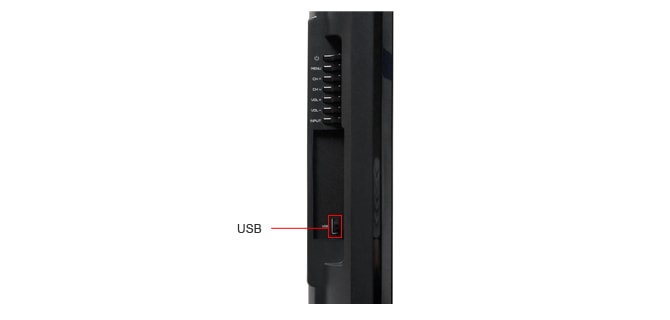
Placement
{{section_header}}{{section.name}}{{/section_header}}
The port placement on this TV is decent. While all the ports are generally located in the same area on the back of the TV, they're indented a bit far from the side and the TV doesn't swivel. Additionally, the sides of the TV don't contain any helpful A/V ports.
Audio Quality
{{section_header}}{{section.name}}{{/section_header}}
The Toshiba 32C100U has relatively poor speakers, as far as we could hear. They sound thin and tinny, with barely any bass to speak of. If you care about audio, you should definitely invest in an external sound setup.

Menu Interface
{{section_header}}{{section.name}}{{/section_header}}
The menus on the Toshiba 46G300U are fairly straightforward.The main menu groupings only have icons, no descriptive text, which can be slightly confusing at first. Fortunately, the images are pretty evocative, however, so it shouldn't be too hard to figure out what's what.

Instruction Manual
{{section_header}}{{section.name}}{{/section_header}}
The instruction manual that ships with the Toshiba 32C100U is decent, but there's no index in the back to look up features alphabetically. Also, the print is small. Toshiba's support site for the product is here, but currently there's no option to download the manual.

A manual for so many TV models, they have to be further categorized by type.
Internet Features
{{section_header}}{{section.name}}{{/section_header}}
The Toshiba 32C100U doesn't have any internet connectivity.
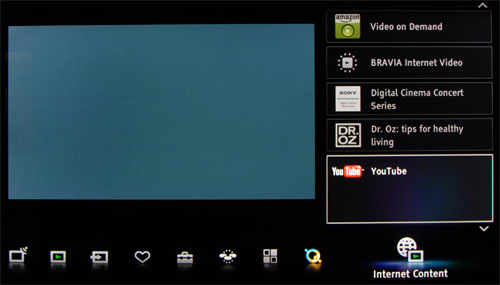
Local Media Playback
{{section_header}}{{section.name}}{{/section_header}}
The TV has some basic media playback features, including photo playback. Just plug in a USB device and you'll get a pop up asking if you want to open the media player.
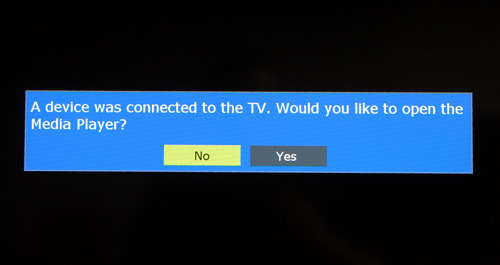
From here, you can choose whether you want to play back photos or music. Choosing photos bumps you to a grid full of folders and picture thumbnails.
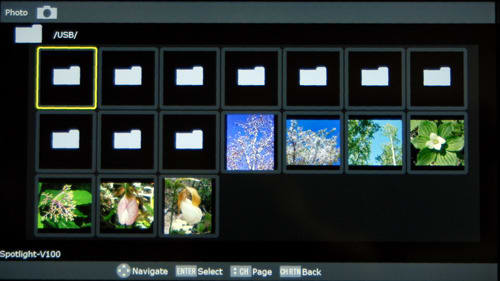
The photo viewer also has some special menu options, which allow you to sort the images, change the interval at which the slideshow progresses, and add a repeat feature.

The slideshow feature will let you add music.
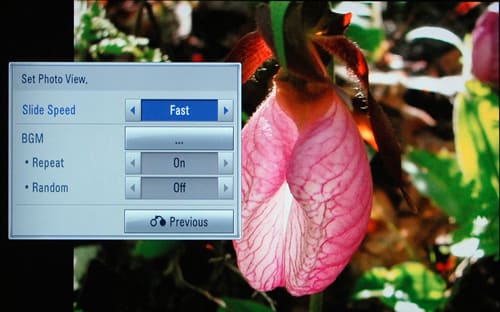
The music player interface is about as basic as the photo viewer. The left window lists the folder hierarchy, and the right shows the song's progress.
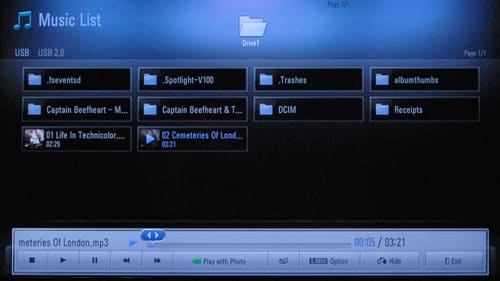
Other Media
{{section_header}}{{section.name}}{{/section_header}}
The TV doesn't have any additional media features.
Power Consumption
{{section_header}}{{section.name}}{{/section_header}}
Although the Toshiba 32C100U isn't the most expensive TV to maintain, it will cost you a few dollars more annually. If you want to reduce the yearly cost, you can cut the backlight to save $10 or so. At zero backlight, though, the TV is so dim it's almost unwatchable. Hopefully your budget can allow for the extra $0.83/month to ensure a viewable television.
As you can see below, the 32C100U is more expensive than some of the other 32-inch LCDs out there, but just by $5-6 per year.
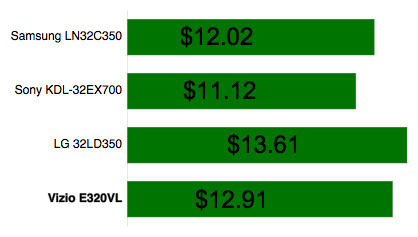
Value Comparison
{{section_header}}{{section.name}}{{/section_header}}
This is a battle of budgets. If you really don't mind taking a hit to picture quality to save $100, the Vizio is the better choice. If you want to spend a bit more for some extra quality, the 32C100U is the better option.
Blacks & Whites
{{section_header}}{{section.name}}{{/section_header}}
The Toshiba had a significantly deeper black level, but the Vizio was much, much brighter. The Toshiba's overall contrast ratio was much higher than the Vizio's, however.

Color Accuracy
{{section_header}}{{section.name}}{{/section_header}}
The Vizio's color temperature is less volatile than the Toshiba's, but the Vizio's RGB accuracy wasn't as good as the Toshiba's.
Motion
{{section_header}}{{section.name}}{{/section_header}}
The Toshiba had far less motion blur than the Vizio. Both had some artifacting issues, however.
Viewing Effects
{{section_header}}{{section.name}}{{/section_header}}
The Toshiba had a slightly wider viewing angle than the Vizio, but not by an amount the average viewer would notice.
Connectivity
{{section_header}}{{section.name}}{{/section_header}}
The Vizio has a two more ports than the Toshiba, but neither are particularly well-connected. A small number of ports isn't strange for a 32-inch TV.
Value Comparison
{{section_header}}{{section.name}}{{/section_header}}
The LG put up better numbers on our black & white and color tests, is better looking, and costs less than the Toshiba. We'd recommend it over the Toshiba unless you find the 32C100U on sale for less.
Blacks & Whites
{{section_header}}{{section.name}}{{/section_header}}
The Toshiba has a deeper black level than the LG, but it's significantly less bright. As a result, the LG wound up with a much higher contrast ratio overall.

Color Accuracy
{{section_header}}{{section.name}}{{/section_header}}
The LG had less fluctuations in its color temperature, but both TVs had about the same RGB performance.
Motion
{{section_header}}{{section.name}}{{/section_header}}
Both TVs had roughly the same motion performance: minor issues with motion blur and some noticeable issues with motion artifacting.
Viewing Effects
{{section_header}}{{section.name}}{{/section_header}}
The LG's viewing angle was pretty narrow. The Toshiba had the wider viewing angle, but compared to any given plasma TV, none of the LCDs listed below seem particularly impressive.
Connectivity
{{section_header}}{{section.name}}{{/section_header}}
The LG has a couple extra ports that the Toshiba doesn't. Otherwise both feature the status quo connectivity for a 32-inch HDTV.
Value Comparison
{{section_header}}{{section.name}}{{/section_header}}
This match-up is about your budget and what you're looking for in a TV. The Sony has better overall picture quality and also offers online connectivity. While the online connectivity boasts one of the largest, best selection of content that's currently available from internet-capable HDTVs, it comes at a premium: the Sony costs more than twice what the Toshiba does. If you don't mind spending money on quality and functionality, the Sony is, hands-down, the better choice. If you don't need online connectivity or perfect picture quality on your 32-inch TV, the Toshiba is probably the better option.
Blacks & Whites
{{section_header}}{{section.name}}{{/section_header}}
The Sony didn't quite have the black level the Toshiba did, but it's brightness more than made up for the deficit: the Sony's contrast ratio is more than twice what the Toshiba can offer.

Color Accuracy
{{section_header}}{{section.name}}{{/section_header}}
While the Sony had marginally worse color temperature consistency, it had better color representation overall.
Motion
{{section_header}}{{section.name}}{{/section_header}}
The Sony had fewer motion problems, both in terms of artifacting and blur.
Viewing Effects
{{section_header}}{{section.name}}{{/section_header}}
The Toshiba had a slightly wider viewing angle than the Sony, but we doubt the average consumer would notice the difference.
Connectivity
{{section_header}}{{section.name}}{{/section_header}}
The Sony has more, better connectivity options. Not only do you get more ports, but you also get internet connectivity. Sony's online suite is currently the best on the market, so this feature offers some significant value.
Conclusion
The Toshiba 32C100U isn't the greatest TV and it isn't particularly attractive, but at $450, it's a good price for a 32-inch set. It also has some decent picture quality that, while far from stellar, will be good enough for the average user. If you're a utilitarian and don't care much about frills, the 32C100U is a fine purchase, and you'll even get some rudimentary media playback options.
Model Series Comparison
{{section_header}}{{section.name}}{{/section_header}}
The C100 Series is entry-level and therefore doesn't have any real feature to speak of. They're just basic TVs on the smaller side of the size spectrum.
Photo Gallery
{{photo_gallery "Front Tour Image", "Back Tour Image", "Sides Tour Image", "Stand Photo", "Controls Photo", "Remote Control Photo", "Connectivity Tour Image 1", "Connectivity Tour Image 2", "Connectivity Extra Photo", "Menu Main Photo", "Menu 2 Photo", "Internet Features 1 Photo", "Internet Features 2 Photo", "Internet Features 3 Photo", "Local Media Playback 1 Photo", "Local Media Playback 2 Photo"}}
Ratings & Specs
{{manufacturer_specs_table}}
Meet the tester
Mark Brezinski works on the Home Team, reviewing refrigerators, minifridges, dishwashers, washing machines, dryers, air conditioners, air purifiers, and fans.
Checking our work.
Our team is here for one purpose: to help you buy the best stuff and love what you own. Our writers, editors, and lab technicians obsess over the products we cover to make sure you're confident and satisfied. Have a different opinion about something we recommend? Email us and we'll compare notes.
Shoot us an email
